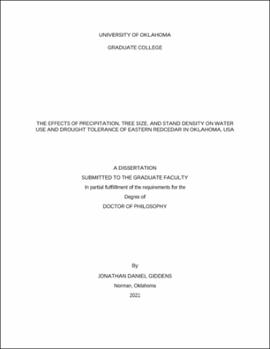| dc.contributor.advisor | McCarthy, Heather | |
| dc.contributor.author | Giddens, Jonathan | |
| dc.date.accessioned | 2021-05-14T19:46:25Z | |
| dc.date.available | 2021-05-14T19:46:25Z | |
| dc.date.issued | 2021-05-14 | |
| dc.identifier.uri | https://hdl.handle.net/11244/329584 | |
| dc.description.abstract | Plant woody encroachment and its effects on the local water budget have become of increasing concern globally as woody plants continue to expand their geographic range into grasslands at a faster rate each year. In the Great Plains Region of the United States, woody plant encroachment has begun to replace native grasslands at an accelerating rate. The replacement of native grassland species with woody plants, such as trees and shrubs, affects the local water budget due to increased rooting depth and altered landscape phenology. Eastern redcedar (ERC, Juniperus virginiana, L.) is an evergreen tree that remains physiologically active year-round and is considered one of the fastest encroaching species in the Great Plains, converting grasslands into closed canopy forests in as little as 60 years.
In Chapter 2 I aimed to identify the source of ERC water uptake, including groundwater, along a precipitation gradient in Oklahoma using stable hydrogen and oxygen isotopes from stem, soil, and groundwater samples. This will allow us to predict how ERC may respond to a changing climate that is predicted to be warmer and drier. As ERC expands its range, it is already thriving in areas that were historically unsuitable. In Chapter 3 I assess how ERC cellular and tree level water stress and stress tolerance varies with tree size in a sparsely versus highly encroached stand. Further, in chapter 4, I quantify transpiration of ERC at the tree and canopy level among ERC of varying size and density using Granier style thermal heat dissipation probes. As the replacement of native grasses with woody plants becomes increasingly common, it will be important to understand how the function of encroaching plants is shaped by environmental pressures. | en_US |
| dc.language | en_US | en_US |
| dc.rights | Attribution-NoDerivatives 4.0 International | * |
| dc.rights.uri | https://creativecommons.org/licenses/by-nd/4.0/ | * |
| dc.subject | Plant Ecophysiology | en_US |
| dc.subject | Stable Isotopes | en_US |
| dc.subject | Sapflux | en_US |
| dc.subject | Drought Tolerance | en_US |
| dc.subject | Woody Encroachment | en_US |
| dc.title | The effects of precipitation, tree size, and stand density on water use and drought tolerance of eastern redcedar in Oklahoma, USA | en_US |
| dc.contributor.committeeMember | Souza, Lara | |
| dc.contributor.committeeMember | Xiao, Xiangming | |
| dc.contributor.committeeMember | Hoagland, Bruce | |
| dc.contributor.committeeMember | Adams, Henry | |
| dc.date.manuscript | 2021-05-04 | |
| dc.thesis.degree | Ph.D. | en_US |
| ou.group | College of Arts and Sciences::Department of Microbiology and Plant Biology | en_US |
| shareok.orcid | https://orcid.org/0000-0002-7209-2501 | en_US |

